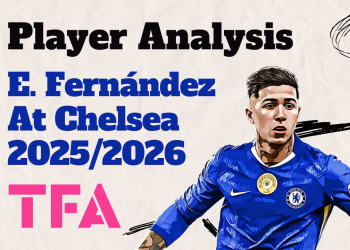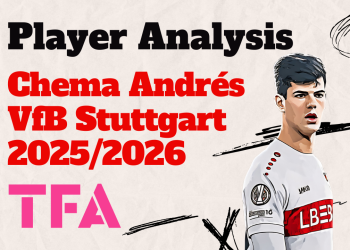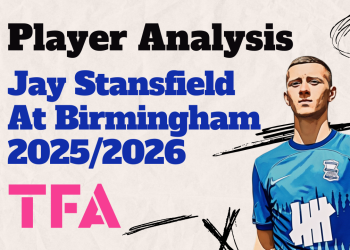Ajax Amsterdam is home to one of the most renowned footballing academies in the world. Their academy, De Toekomst, is respected by every international club for their ability to develop and train youth talents, making winners and selling them for high margins to other clubs. Notable amongst these talents were Johan Cruyff, Marco Van Basten, Frank Rijkaard, Dennis Bergkamp, and many more legendary names. Recently, they made Wesley Sneijder, who went to Real Madrid, Matthijs De Ligt, who went to Juventus, and Christian Eriksen to Tottenham Hotspur. The CIES Football Observatory even named Ajax the best stepping-stone club to the world’s top leagues and teams.
One of the new players fresh off their conveyor belt is Ryan Gravenberch. The 18-year-old is familiar to Football Manager players worldwide for his talent and potential. In this scout report, we will be performing an in-depth analysis of the Dutch wonderkid’s performances this season. We will conduct a tactical analysis to evaluate his strengths and weaknesses. We will also examine how he fits into Ten Hag’s tactical approach.
Ryan Gravenberch Player Overview
Ryan Gravenberch is primarily a central midfielder who can also play as a central defensive midfielder. At 190 centimetres, he is very tall and has an excellent physique for his age. In a midfield of three, he is generally the deepest of the trio and acts as the holding midfielder. He is the youngest ever debutant for Ajax at the age of 16 and has played 513 minutes in an Eredivisie season that was cut-off prematurely. He primarily plays for Ajax II in the Eerste Divisie. We can see his role in the heat-map below for this season:

He does not provide a lot in the final third, or in his box, as we can see above. However, he is all over the pitch in the midfield areas, especially on the left midfield side. As we can see here, Gravenberch does not only stay in the defensive midfield positions but moves to advanced positions as well, aiding Ajax in the attack. This boils down to his skills. He is good defensively in providing stability when Van De Beek and Ziyech attack, and is excellent when on-the-ball as well.
Ryan Gravenberch Defensive Abilities
Due to his height and weight, Ryan Gravenberch is the ideal deep midfielder. Despite playing as an advanced playmaker in Jong Ajax, Ten Hag deploys Gravenberch to stick to his position and provide stability for his backline. Below, we can see his statistics so far this season defensively:

An essential role of the holding midfielder in a possession-based team like Ajax is their interceptions and their defensive recoveries. Gravenberch excels in both these metrics and is far above the league average in both. He attempts and wins 6.2 defensive duels with a success rate of 67%. Defensive duels are the attempts of a player to dispossess their opponents to stop an attack from progressing. Thus, having a high number of defensive duels attempted and winning more defensive duels shows that he is successful at stopping goals and indicates why Ajax have been strong defensively this season compared to other teams in the Eredivisie. Gravenberch wins most of his battles in the centre of the pitch and tends to gain back possession of the ball, which is admirable and complements Ajax’s possession-based style.
Another important metric for defensive midfielders is the Interceptions. The interception values here are adjusted for possession and are higher than the median league average at 4.22 per game. The high value means that Gravenberch stops an attack by smartly reading the play and blocking the ball before the opponent can get to it.
A typical defensive duel for Gravenberch plays out like below:

In this game against Vitesse Arnhem, we can see Ryan Gravenberch, who is the closest midfielder to the backline, already picks his man, the opponent’s attacking midfielder. He trails him and covers any a) Through balls from the central defender to the striker, and b) The goal for the Vitesse midfielder.

The moment the centre-back releases the ball to the attacking midfielder, Gravenberch frees himself from his position to get the ball back from the midfielder. His agility and speed when going to get the ball are unmatched for his age and level in his position, and they play an integral part in his success.
The next thing we can see is Gravenberch’s aggression. He pounces on his opponent and goes for an opening to get the ball and distribute it to his teammates. In this scenario, Gravenberch wins the ball back, gets it to Ryan Babel, and creates a goalscoring opportunity.
Gravenberch is intelligent while defending, more intelligent than his peers at the same age level. Above, we can see all the techniques he regularly utilises to win the ball. Firstly, he keeps track of the current position of the ball and his marker, ensuring that a through ball is not made by a player in possession, and keeps his marker under check. Next, he forces the marker in possession to face his own goal instead of Ajax’s. Next, he times his run towards the opponent and retrieves the ball.
However, he still has considerable room to improve in aerial duels. He wins only 45% of his aerial duels that he attempts. This number is quite poor, considering he is taller than most of his peers at the same level. As a holding midfielder, he is supposed to be aggressive in the air and is at the 30th percentile for winning aerial duels in central midfielders.
Ryan Gravenberch Transition Phases and Passing
As a team that depends on possession a lot, Transition and passing play is vital for Ajax. Gravenberch’s most exceptional skill here is his ability to accelerate quickly and turn around from defending to attacking, or vice versa. He uses his agility and acceleration to promptly bring the ball out of defence by making long progressive runs into the final third of the pitch. This season, he has made 3.16 progressive runs per 90, which is in the top 10 in the league. While this is already great for a player of his age and experience, the average distance he has run this season is even better. In the league, he has the highest progression distance at 106.55 metres. We can see this play out below:

Here, we can see Gravenberch (in black) win the ball in his area. Then, he immediately turns and dances past two defenders. That’s the first advantage of his fabulous physique: His ability to twirl past defenders that face him with Roulettes and Cruyff Turns and beat them with ease. The other thing we can see is that Gravenberch has a lot of space in front of him, so he beats the man and accelerates past him. This manoeuvre is advantageous as Gravenberch now has a lot of space to distribute the ball to his teammates.
His off-the-ball movements are brilliant too. He always tries to find space between passing lanes and empty areas of the pitch. Gravenberch creates space around him by identifying zones with lesser pressure and move into them to receive passes. This technique is evident when examining his received passes, which average 40.52 per game, making him one of the best in the league.
His passing ability is what we will examine next. Despite not having played many games so far this season, Gravenberch has demonstrated his ability to pass well and has an innate vision for picking out good passes. The Ajax philosophy inculcated in him is to make a lot of passes by controlling the ball. His passing accuracy sits at a whopping 89%, which is an excellent figure for any central midfielder. While his pass length is at an average of 17.2m, he makes mostly forward passes, as we can see in this pie chart below:

As we can see above, Gravenberch attempts mostly forward passes, with 61.2% of his passes being forward. He also makes a fair amount of backward passes too, which is because Ajax’s system rotates around the distribution of the ball throughout the entire team.

The graph above provides a more detailed breakdown of the types of forward passes Gravenberch attempts in every game. As a hybrid deep midfielder, Gravenberch is instructed to be a part of the attacking system under ten Hag and is thus required to make a lot of forward passes. The type of pass that Gravenberch makes the most are passes to the final third. This is because he plays near the middle of the pitch when making passes. So, most forward passes he attempts will enter the final third.
However, young age and a lack of experience mean that Gravenberch still has a lot to improve for the future. He wastes a lot of time on the ball and does not make the best possible decision at the best possible time. Gravenberch has an alarming number of ball losses for a holding midfielder, standing at 7 per game.
Ryan Gravenberch Attacking ability
From his role as the deep-lying midfielder, Gravenberch is tasked with getting the ball into the final third of the pitch to create goal-scoring opportunities. He does this in two ways: Passing the ball into the penalty area or the final third; or by dribbling into the final third.
We have seen Gravenberch making progressive runs, but now we will focus on his dribbling when in possession of the ball.
Gravenberch’s pace on the ball is remarkable, and he has good and adaptable close ball control when needing to attack. This season, Gravenberch has attempted 3.67 dribbles per game, a number that is impressive for his age. However, his dribble success percentage sets him apart from the rest of the midfielders. He ranks highest in the Eredivisie with a success percentage of 67%, meaning that he completes every two dribbles out of three that he attempts.

The example above shows a dribble that Gravenberch frequently makes. He receives the ball when facing the goal, and has a bit of space to go past his opponents. Gravenberch drives past the first two defenders by performing a roulette move and entering the danger area. He then cuts inside and beats the other two defenders in the box and is through on goal. Gravenberch dances past these defenders, much like Paul Pogba, using his tall frame to find his teammates or create goalscoring opportunities himself.
The map below shows his dribbles that he has attempted so far in the season:

There are various takeaways from the map above. Firstly, we can see the high volume of dribbles that Gravenberch attempts from various positions on the pitch. Around one-third of his dribbles start in his own half, and complements what we saw regarding his long progressive distance run. Another key takeaway is his ability to play in various positions. So far this season, Gravenberch has played at right-back, centre-back, defensive midfielder, central midfielder and central attacking midfielder. From each position, he has completed various dribbles from the entire pitch. This demonstrates his two-footedness and ability to handle dribbling from any part of the pitch.

The graph above indicates Gravenberch’s attacking metrics. He attempts a high volume of shots but needs to sharpen his finishing ability. The map below shows where Gravenberch generally shoots from:

As we can see, he attempts many shots from outside the box and from the side. These are areas with lower xG, meaning that the chances of a shot going in from there are lesser. Gravenberch needs to improve on this regard. He is good at entering the final third through key passes and dribbles. However, he is unable to convert them into goals. He has an xG of 0.19 per game and scores around 0.18 goals per game. This statistic suggests that Gravenberch has the potential to score more goals than he already does, and if he sharpens his finishing, he can score a significant number of goals every season.
Conclusion
Gravenberch should be getting more minutes in the upcoming season and be trusted by Ten Hag. If Van De Beek leaves for Real Madrid, Gravenberch could be moved to a more advanced position, as it complements his skills very well too.
While Gravenberch shows a lot of skill already, he is only 18 years of age. Gravenberch still has a lot to learn and has time to develop his skills. His talent for youngsters in the Eredivisie is second to none, as we have seen in this analysis. But he still has a lot to work towards, like his aerial duels and finishing. Gravenberch has generated a media buzz around him, and if he continues his development with Ajax Amsterdam, he should become one of the greatest products of the academy.






![Napoli Vs AC Milan [2–0] – Supercoppa Italiana 2025/2026: How Antonio Conte Tactics Punished Rossoneri Errors – Tactical Analysis 15 Napoli Vs AC Milan 20252026 - tactical analysis](https://totalfootballanalysis.com/wp-content/uploads/2025/12/Napoli-Vs-AC-Milan-20252026-tactical-analysis-1-350x250.png)





